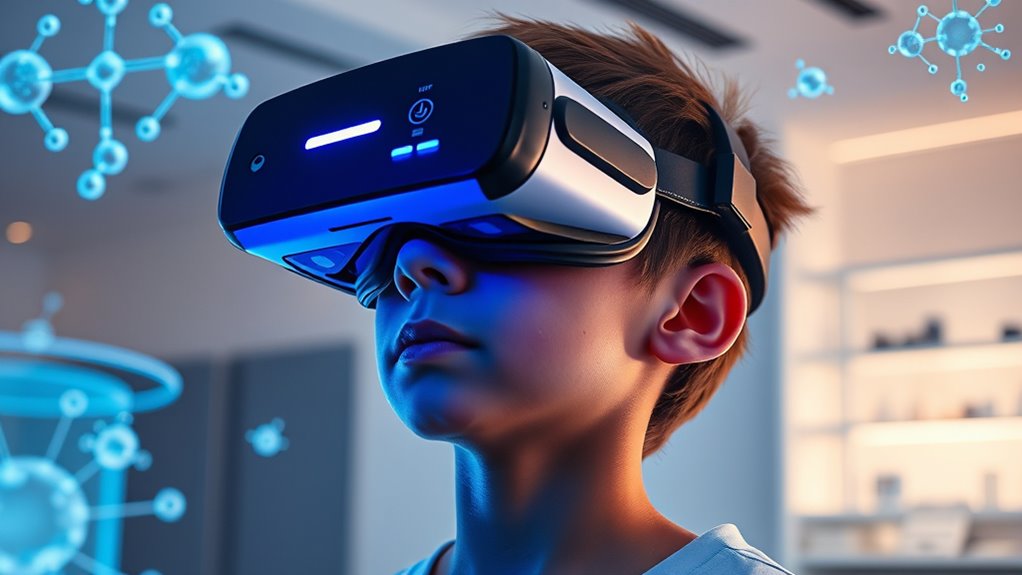Exploring virtual museum tours and science labs allows you to access world-class collections and experiments from anywhere. You can walk through digital galleries, examine artworks in high detail, and participate in interactive scientific activities safely online. These resources make learning fun, engaging, and accessible for all, breaking down geographical and financial barriers. If you’re curious about how these digital experiences can boost your knowledge and skills, keep exploring to discover more.
Key Takeaways
- Virtual museum tours and online science labs enable remote exploration of art, artifacts, and scientific experiments without physical travel.
- They offer interactive features like high-resolution images, 3D models, videos, and audio guides for immersive learning experiences.
- These digital resources democratize access to educational content, breaking geographic and financial barriers.
- Virtual labs allow safe simulation of experiments, enabling manipulation of variables and data analysis digitally.
- Overall, they transform traditional education by providing engaging, accessible, and cost-effective learning opportunities worldwide.

Have you ever wished you could explore world-class museums or conduct science experiments without leaving your home? Thanks to virtual museum tours and online science labs, that wish can become a reality. These digital experiences allow you to immerse yourself in fascinating collections and hands-on activities without the need to travel or set up complicated equipment. Whether you’re a student, a teacher, or just a curious explorer, online platforms make it easier than ever to access knowledge and interact with educational resources from anywhere.
Discover world-class museums and science labs online—explore, learn, and engage from anywhere in the world.
When you take a virtual museum tour, you get to walk through galleries filled with incredible displays of digital art and historical artifacts. Instead of visiting in person, you can explore masterpieces and ancient relics via high-resolution images, 3D models, and interactive features. This digital access opens up opportunities to examine details you might miss in a physical setting, like the brushstrokes of a painting or the inscriptions on a relic. Plus, many virtual tours include detailed descriptions, videos, and audio guides, enriching your understanding of each piece’s historical and cultural significance. This way, you don’t just look at objects; you learn their stories, making your experience both educational and engaging.
Similarly, online science labs give you the chance to perform experiments without the mess or safety concerns of a traditional lab. These virtual labs simulate real-world experiments, allowing you to manipulate variables, observe reactions, and analyze data in a controlled digital environment. You can explore topics like chemistry, physics, and biology at your own pace, gaining practical skills without leaving your home. Many platforms incorporate interactive tutorials and step-by-step instructions, helping you understand complex concepts through hands-on practice. This approach makes science accessible and enjoyable, especially if you don’t have easy access to physical lab equipment or if you’re looking to supplement your classroom learning.
Both virtual museum tours and science labs harness the power of technology to democratize education. They break down geographical and financial barriers, giving you access to world-class collections and cutting-edge experiments with just a computer or tablet. As you navigate through these digital environments, you’re not only gaining knowledge but also developing digital literacy skills that are *indispensable* in today’s interconnected world. Additionally, cost and savings analysis confirms that virtual resources can be a cost-effective alternative to physical visits, making quality education more affordable. Whether you’re marveling at digital art, uncovering the secrets of ancient artifacts, or experimenting with scientific phenomena, these online experiences make learning interactive, exciting, and accessible for everyone.
Frequently Asked Questions
How Can I Access Virtual Museum Tours on Different Devices?
You can access virtual museum tours on different devices by checking device compatibility first. Most tours are accessible via web browsers, so you simply visit the museum’s website. For some experiences, you might need to download an app, so make certain you install the app compatible with your device. Whether you’re on a smartphone, tablet, or computer, following these steps makes exploring virtual tours easy and enjoyable on any device.
Are Virtual Science Labs Suitable for All Age Groups?
Virtual science labs are generally suitable for most age groups, but you should consider age appropriateness for younger children. They offer great educational benefits, like hands-on learning and interactive experiments, which can boost curiosity and understanding. For older students, these labs provide advanced concepts and real-world applications. Always check the platform’s recommended age range to guarantee the experience matches your child’s developmental level and educational needs.
What Are the Technical Requirements for a Seamless Virtual Tour Experience?
Like a finely tuned orchestra, a seamless virtual tour relies on the right setup. You’ll need hardware compatibility with your device and a robust internet speed to prevent lag or buffering. Make certain your computer or tablet meets software requirements, and your connection is fast enough—ideally 25 Mbps or higher. This combination guarantees smooth navigation, vivid visuals, and an immersive experience that feels almost real.
Can Virtual Labs Replace Hands-On Science Experiments Entirely?
Virtual labs can’t fully replace hands-on science experiments because digital experiments and virtual reality lack the tactile experience and fine motor skills development you gain from physical interactions. While virtual reality offers immersive learning and safe environments to explore complex concepts, it doesn’t replicate the sensory feedback or real-world unpredictability of actual experiments. Combining both approaches provides a balanced, all-encompassing science education, enhancing understanding without entirely replacing traditional methods.
Are There Interactive Features Available During Virtual Museum Visits?
Imagine stepping into a digital world where you’re greeted by vibrant interactive exhibits that come alive at your fingertips. Yes, virtual museum visits often feature engaging interactive exhibits and educational games that make exploring history, art, or science fun and immersive. You can click, drag, and even participate in quizzes, transforming your screen into a lively space that sparks curiosity and enhances learning.
Conclusion
So here you are, marveling at virtual museums and science labs, thinking you’ve got the world at your fingertips. Ironically, while you can explore endless exhibits from your couch, you might miss the thrill of actually standing in front of a masterpiece or conducting hands-on experiments. Technology offers incredible access, but sometimes, it’s the real, messy experience that leaves the biggest impression. After all, some things just can’t be fully replaced by a screen.










